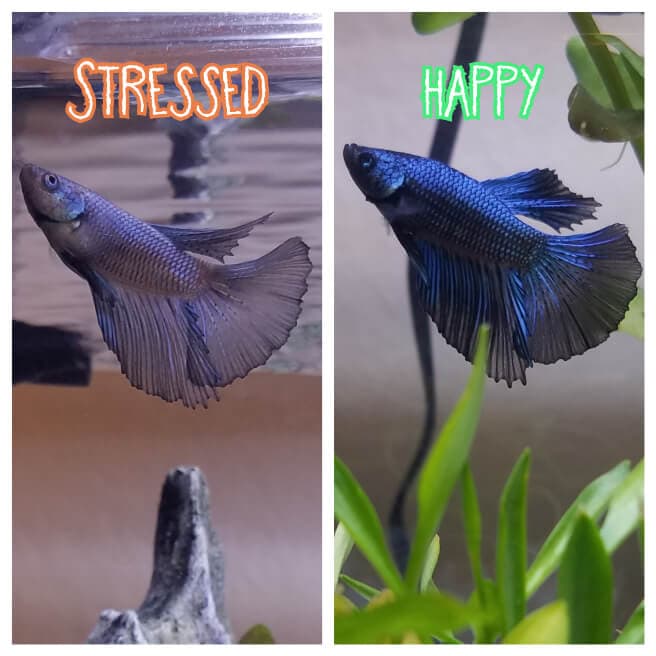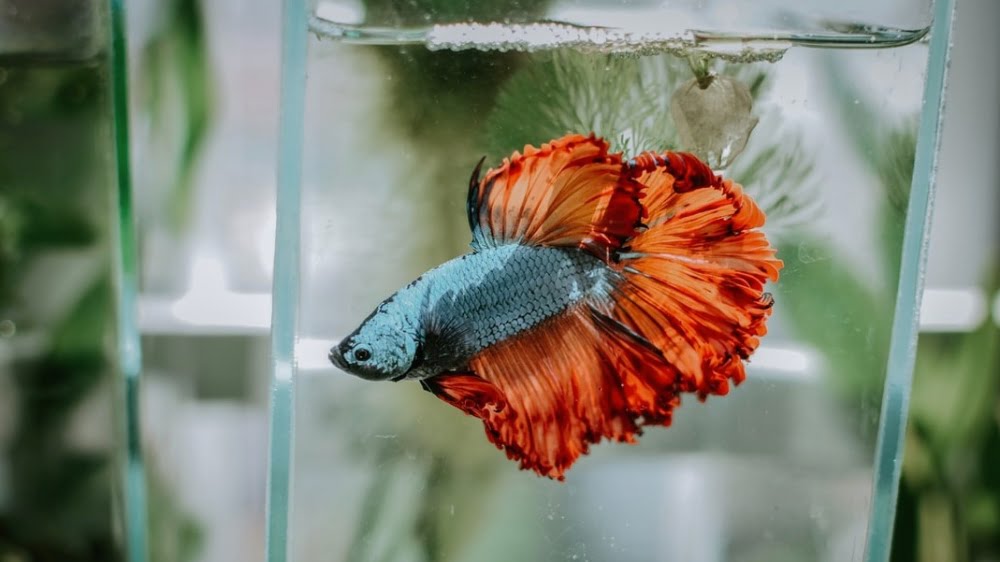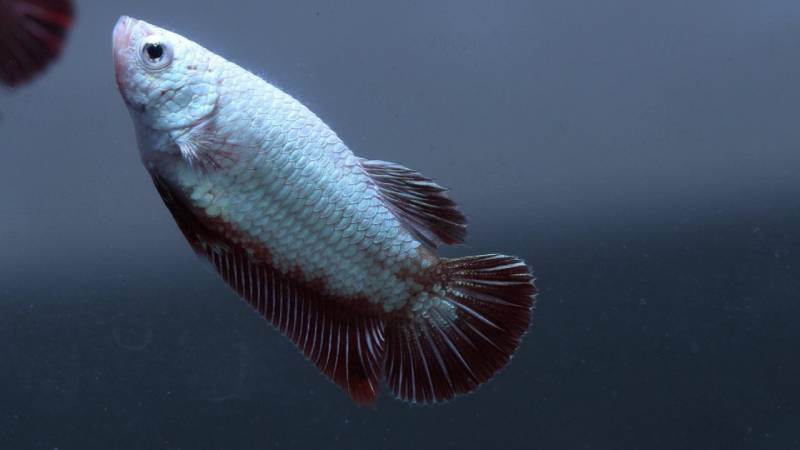Do Betta fish change color?
My answer to you is “YES”. However, among Betta species, they have very separate reasons for colour change.
But a researcher has listed a few reasons why fish easily change colour, such as the surrounding environment causing the fish to change or stress also causing the fish to change its colour.
The telltale sign of them changing colour is that their bright colours begin to gradually turn black or white.
In this article, you and I will find out the reasons why Betta fish change their colour.
Common Reasons Why Do Betta Fish Change Color
As I dug deeper into the matter, I discovered a few things that cause the Betta fish to change their color.
The main reasons are:
- Fish will change the colour of their bodies when they are stressed.
- The environment is also a factor affecting their change.
- The disease is a common cause for fish to change colour easily.
- Another reason is puberty and growth.
Change Color Because Of Stress

The colour changes on the body of fish are similar to the changes humans make when they are stressed. People will react to this stress by expressing anger, their faces will turn red.
The Betta fish, too. They will exhibit physical responses in response to this stress. Besides, these physical reactions will help aquarists better understand their current condition.
The change commonly seen in these fish is that their colour will appear discoloured or dull. If they are overstressed, they will lose their colour temporarily. In this case, there is a term called “stress stripes.”
Some aquarists are not professional or do not know any knowledge enough, they often buy these fish with stripes to home without knowing it is a sign of stress.
Stripes on the body of the fish are a sign of stress in the fish. This stripe usually appears horizontally on Betta’s body. These stripes often extend from the fish’s gills down to their tails and colour to tell if they are black, red, white, or a combination of colours.
But why does this stripe appear on their body?
If you observe these streaks then you should check its aquatic environment and make a few changes to reduce its stress again.
Check the temperature in the water tank regularly as heat is also a source of stress for this fish. Make sure the water temperature in their tank is from 78*F to 80*F.
Another factor that can easily cause stress for fish is the level of ammonia and nitrate in the tank, check to see if they are within the allowable range.
To check the level in the tank, you’d better purchase an aquarium water test kit. This tool will help you easily detect the change in fish when their internal water level changes.
The Surrounding Environment Affects Their Color Change

Have you ever bought a betta that had a certain color when it was in the store, but when you brought it back, it changed color in your aquarium?
This is a fairly common case among fish keepers. Shops sometimes do not provide the best environment for the fish being sold there. So, provide a really clean amount of water and make sure the environment inside the tank is fresh, then the fish will start to regain their colour.
After the fish have had enough time to settle into their new school, the Betta fish will grow and have a richer color. When buying a Betta, make sure you have a well-prepared aquarium. Also, keep at least 2.5 gallons of water in the tank.
The temperature in the tank should range from 78*F to 80*F. You should not change the tank too often until the fish are accustomed to the new environment.
When moving to a new and healthier environment, the Betta will slowly become stress-free and the colour will gradually become brighter.
On the other hand, if a Betta’s living conditions deteriorate, it is possible that it will begin to lose its colour, and may even turn black or white.
Illness Also Affects The Color Change Of Fish

In addition to the two factors mentioned above, there is another factor that also significantly affects the color change of Betta, which is the disease.
Betta fish usually tend to turn pale, which is an indication of a problem with the fish’s health. This is a sign that the fish is having health problems, so when you go to the store, pay attention to these characteristics.
The common diseases in fish are fungal and bacterial infections, which will make the fish pale.
Please observe and research carefully before deciding to buy it.
Puberty and growth

When you go to the store to buy a Betta when it is very young, it will most likely change colour until it is an adult. As the fish matures, it will either darken or become lighter and more prominent than when it was young.
Not all Betta fish have a darker colour as they grow older, but most of its common colours are.
The reason you can not see this colour change is that most stores sell mature and developed fish.
So, fish enthusiasts often miss this growth phase of fish.
How To Maintain Or Boost Betta Fish Colors
- Ensure your Betta fish has a heater and a quality filter. The water will stay clean and the Betta fish will be happy with a good filter.
- If you intend to keep a Betta fish in a fishbowl, ensure it has enough room in a minimum five-gallon tank.
- Your Betta fish should not be left in dirty tank water if the water becomes dirty. Change the water as soon as possible.
- Diets that are rich in vitamins, nutrients, and proteins can make Betta fish more colourful. A good nutritious diet along with healthy living conditions can make your Betta fish vibrant and beautiful.
- Vitamins, nutrients, and proteins can enhance the colour of Betta fish when they eat a diet rich in these components. Include a wide variety of foods such as freeze-dried foods, live foods, and even high-quality dry pellets to satiate their carnivorous diet.
FAQs
At what age do bettas change colour?
As early as 2 years old, the colour of a betta can start to fade. Hence, if you are certain it isn’t stressed, it may be part of their natural ageing process.
What color betta is the rarest?
Albino bettas are the rarest betta color in the world.
As with pure black bettas, this fish is so rare that many collectors are unaware that they exist. Observers often identify albino bettas correctly as clear, white, or cellophane bettas when they see them in the news or at auctions.
Why is my red betta fish turning blue?
Marbling occurs when a betta’s light colour gradually fades to reveal blues or reds, especially if they had a few flags of colour at the time of purchase. He is likely to become completely blue as a result. That is to be expected.
Final Words
Betta fish may change colour for a variety of reasons that we discussed above. Stress or illness can cause your Betta to turn pale.
To keep your Betta free from stress and infections, you need to maintain a consistent temperature and a healthy environment.
Whenever your Betta starts to turn grey, it could be an indication of aging. You may have brought in a young fish if the betta transitions into darker color schemes over time.
Video About The Changing Color Of Fish

Annette M. Chaney is an experienced marine biologist with over 20 years of experience as an aquarist and fishkeeper. She started her first aquarium at a young age, filling it with frogs and goldfish obtained from the ten-cent pet store.
Annette grew up caring for and breeding African Cichlids, which led to a hobby in high school that doubled as a profitable means. Attending Reed College gave her time to solidify herself as an accomplished aquarium caretaker with an eye for sales. After that, from 2009 – 2013, she studied at Roger Williams University – one of the most prestigious universities for Aquaculture and Aquarium in USA. She is the founder of AquariumCircle since 2010.
